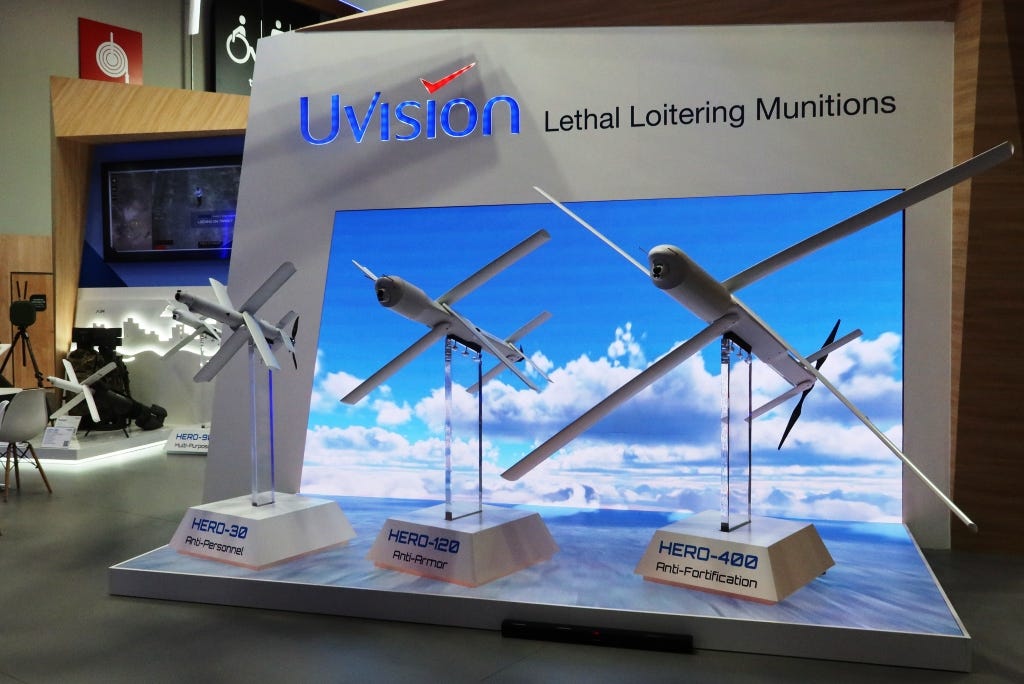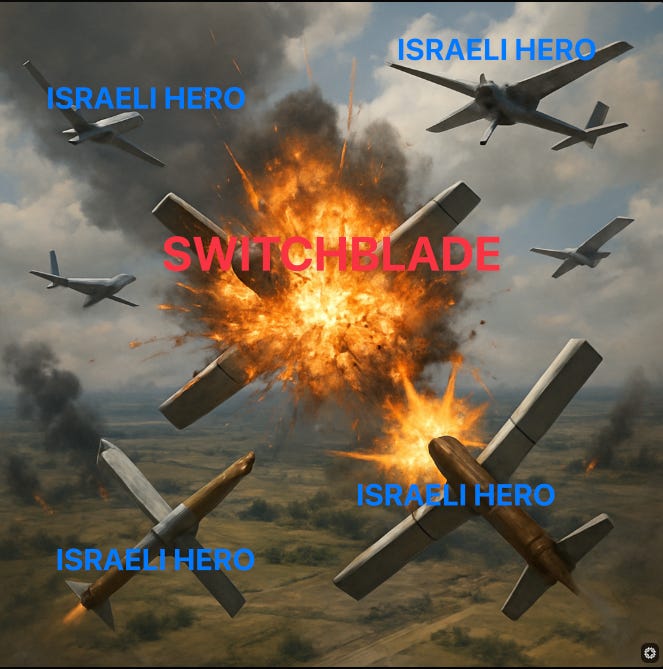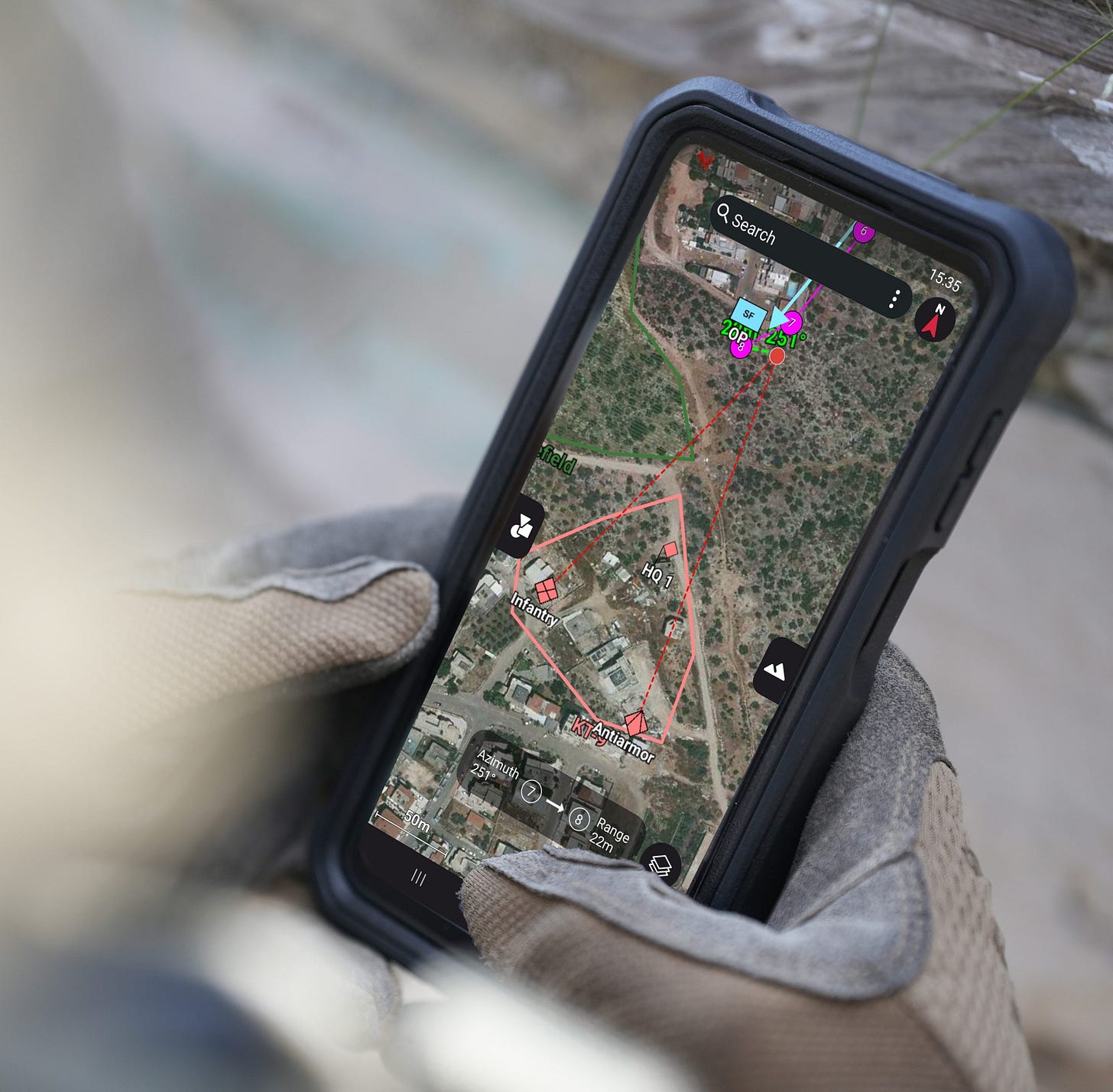A Financial Blueprint For Super-Sparta
Defense-Tech Special Edition includes: Israel Wins Pentagon's Combat Drone Tender; The IDF’s Killer Map App
Welcome to Israel Tech Insider. I’m Amir Mizroch, a tech communications advisor and former EMEA Tech Editor at The Wall Street Journal. This newsletter is about connecting the dots to give you a sharp, insider’s take on what’s really going on in Israel’s tech industry.
As always, feedback to amir@israeltechinsider.com
Israeli Hero outguns Switchblade
Real-world performance is overtaking domestic favoritism in Pentagon procurement
The Pentagon just handed a $982 million loitering munitions (AKA killer drone) contract—not to an American defense giant, but to a Maryland proxy for an Israeli drone maker, UVision. The contract runs through 2030.
That matters because UVision’s Hero drones beat out AeroVironment’s Switchblade—a system the U.S. has already invested nearly $1 billion into—and Anduril’s Altius, backed by the most hyped defense startup in America.
According to Defense Express, it wasn’t even close. The Hero outperformed on range, loiter time, and general bad-assiness, exactly the metrics that matter when drones replace close air support.
So why did the Pentagon override the usual default to domestic firms?And does this mean that the core assumption that “Buy American” always wins? The answer: when timelines and performance diverge, even billion-dollar legacy bets get sidelined.
If this marks a significant shift in procurement strategy then that’s good news for Israeli defense tech firms, who face a labyrinth of American protectionism that would kill most foreign companies: the Buy American Act mandates federal agencies purchase domestically-made equipment, export controls treat defense technology like nuclear secrets requiring US citizens and facilities, and security clearances demand American corporate structures—meaning even a company winning a billion-dollar Pentagon contract must operate through a Maryland intermediary rather than sell directly from Tel Aviv.
Despite all this, Israeli defense tech startups doubled in 2024. The reason? Ukraine and Gaza became brutal proving grounds—battlefields where systems either worked or got soldiers killed. That real-world validation now matters more to Pentagon buyers than decades-old relationships with Boeing or Lockheed. For example, Reuters reports “Around 50% of anti-drone technology used by Israel’s military during the conflict came from startups”.
American venture capitalists are flooding into Israeli defense tech precisely because the traditional defense giants are slow, bureaucratic, and optimized for lobbying rather than innovation, while Israeli startups are shipping battle-proven drones and AI-targeting systems that actually perform when missiles are incoming—creating a possible shift where the next wave of defense unicorns is emerging from a country smaller than New Jersey rather than the Washington Beltway’s contractor fortresses.
The IDF’s Killer Map App
In Gaza, city blocks disappear in hours. Buildings collapse, landmarks shift, and street grids once used for targeting no longer exist by nightfall. For decades, Israeli infantry entered combat zones with compasses, plastic-covered paper maps and grease markers, relics from an offline age. During the October 7 War, that analog era ended.
TheMarker (Hebrew) reports that the vast majority of IDF ground forces now rely on OLAR, a smartphone-sized digital mapping device built by Israeli startup Asio Technologies, which provides real-time battlefield visualization even under GPS jamming or comms denial. The features-packed pocket platform offers the kind of situational awareness typically reserved for air and drone units—now in the hands of frontline infantry. Israel’s air dominance is well established. What’s new is its ground dominance—faster, more precise, more coordinated than anything on record.
But don’t call it a map though: Asio says OLAR is a “geo-spatial position acquisition systems for defense and paramilitary markets.”
Also known by its original name, Orion, the device fuses real-time 3D terrain visualization, positional tracking, mission planning, and intelligence overlays into a single handheld tool. It doesn’t just show where a soldier is—friendly positions are marked in blue, enemy sightings in red. A new route flashes across the screen, avoiding a suspected ambush site identified by drone feed just seconds ago. No radio call. No paper. Just tap, confirm, move.
Think of it as a battlefield iPhone that works even when there’s no signal, no Wi-Fi, no GPS. No problem. The device works offline, drawing from cached satellite data, sensor inputs, and stored mission parameters. When connectivity returns, it syncs. It’s rugged, encrypted, and it never waits for permission to be useful.
This isn’t Google Maps for soldiers—it’s what Google Maps can’t be. Civilian platforms blur sensitive zones, rely on commercial satellites, require constant connectivity, and offer no tactical overlays or access controls. Worse, GPS spoofing or signal jamming—now routine in Gaza and Ukraine—renders most consumer apps useless. OLAR works where comms fail and terrain changes hourly. It’s not just a navigation tool. It’s like Waze for Warfighters.
Founded in 2003 by brothers Tomer and Yaniv Malchi, Asio spent years in relative obscurity, refining its mapping tech for the harshest conditions. Then Gaza became the proving ground. The company grew from 20 to 50 employees in under three years. Revenues are nearing ₪100 million.
The implications extend beyond Israel. OLAR is part of a broader shift in military procurement: away from lobbyist-optimized giants and toward fast, interoperable, war-tested systems. And in this case, one of the most consequential frontline upgrades of the war didn’t come from Lockheed or Rafael—but from a Tel Aviv startup shipping battlefield software in a form factor a soldier already uses for things like Google Maps and Waze. The next war will be fought with handheld command and control systems, AI-augmented vision, and decentralized teams moving with real-time intelligence. And unless they adapt, most Western ground forces are still carrying the 20th century into the 21st.
A Financial Blueprint For Super-Sparta
Israel’s defense chief just made the “Super Sparta” thesis operational. Maj. Gen. (res.) Amir Baram told the Finance Ministry’s Accountant General Conference that Israel is fusing military power and industrial policy into one system—small population, permanent technological edge, economy organized around conflict readiness.
Since October 2023, Israel absorbed ₪205 billion in war costs while closing $2.5 billion in government‑to‑government export deals in a single week, created a National Armament Council to compress procurement cycles, creating a joint Defense‑Tech fund with the Chief Scientist, and is pulling critical production in‑house through vertical integration—controlling multiple steps from components to final assembly—to survive sanctions, vandalism of shipments, economic shocks, and geopolitics.
The plan runs on three tracks: immediate purchases to plug readiness gaps, decade‑scale force expansion, and long‑horizon “game‑changers” for future wars. This taps a roughly $2.7 trillion global defense market growing about 20% annually, where battlefield validation sells.
Baram set explicit goals: domestic independence in systems where foreign dependence creates vulnerability, faster decision cycles than adversaries can match, and using combat‑proven performance to win export contracts. Export revenue finances autonomy.
But capacity is the constraint: every system shipped abroad competes with domestic stockpiles as Iran rearms (Baram said further conflict with Iran is inevitable).
The picture Baram painted is the institutionalization of Super Sparta, an operating system where growth, deterrence, and foreign policy share the same assembly line—and where peacetime is just the resupply window.






You make me feel good Amir. And i needed to feel good. Kicking off with the Sparta almost visible analogy was a good move. Then the fact that this Tell Aviv company got a billion dollar deal improved me even more. Thanks. Followed by the technical jargon on how good this product is went over my head because i dont understand this type of writing but i 100% agree that actual battle field testing is a great benefit. When both these wars stop Israel and Ukraine will make a great team. I confess i have fantasy moments where i am all powerful, like a god, and can make myself invisible, close up to the enemy and neutralise him. Or a different version is that i could put a mark on him then make him understand that he will be neutralise in say 24 hours unless he surrenders or runs away or converts. You know the type of ultimate weapon that would have finished this war so so quickly. And then i wake up . Look what you say is good news but the enemy will get these things also at some point in time. And should we not fall into the trap of technology to win or have security. I further suggest the best weapon is this invisibility power applied to humans I mean if they can do it for planes itsonly a matter of time for robots or people. But dont sell it to anyone. Thank you for your article.